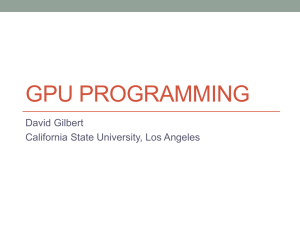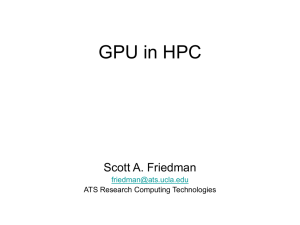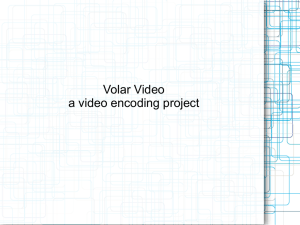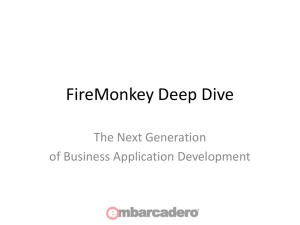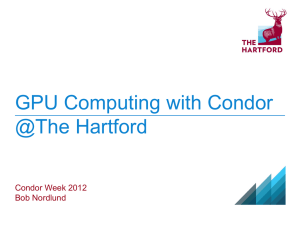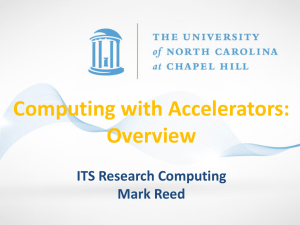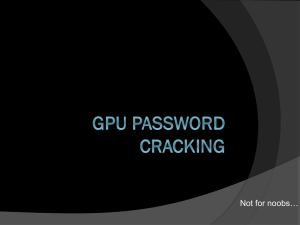MatlabGPUWorkshop2013PowerPoint
advertisement
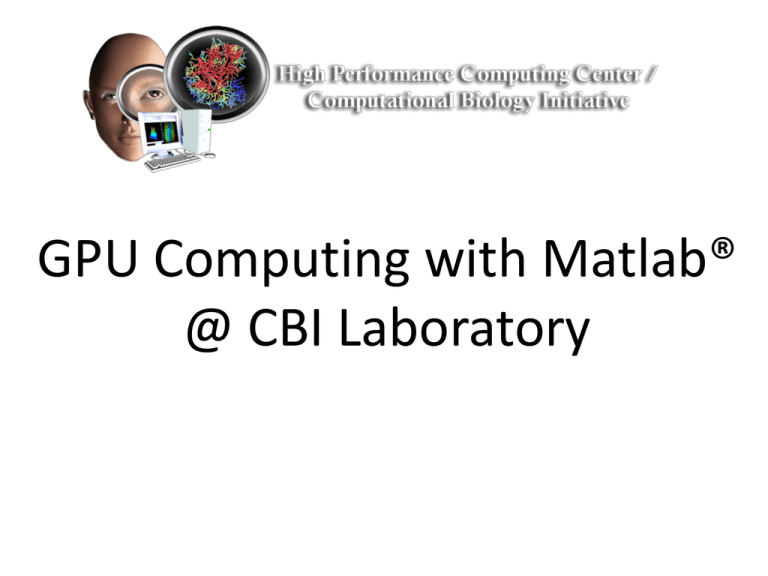
GPU Computing with Matlab® @ CBI Laboratory Overview • GPU History & Hardware – GPU History – CPU vs. GPU Hardware – Parallelism Design Points • GPU Software Infrastructure ( CUDA ) • Matlab Parallel Computing Toolbox, GPU Computing • GPU nodes @ CBI Lab • Examples • Additional Features 2 GPU History 3D object model: e.g. A circle of radius R, @ center (x,y,z) Color = Blue Light Source @ ( x,y,z ) 2 Dimensional Screen Goal: Answer question, for pixel (X,Y) on the screen, what’s my (R,G,B) value 3 GPU History 3D object model: e.g. A circle of radius R, @ center (x,y,z) Color = Blue Light Source @ ( x,y,z ) 2 Dimensional Screen Much Parallelism Available & Screen refresh rate << Processor Clock rate 4 GPU History 3D object model: e.g. A circle of radius R, @ center (x,y,z) Color = Blue Light Source @ ( x,y,z ) 2 Dimensional Screen GPU Model: Assembly Line Concept High Latency BUT High Throughput 5 GPU History MATRIX MULTIPLICATION: e.g. Translation, Rotation, Scaling MATRIX MULTIPLICATION: e.g. Rotation 3d MATRIX MULTIPLICATION: e.g. 3-D to 2-D Projection ( Perspective Projection ) 3d 3d 2d Many Independent Computations: Streams of Triangles & Vertices screen 3 vertices (x1,y1,z1) (x2,y2,z2) (x3,y3,z3) The more calculators: the more points we can move around in the same amount of time GPU History MATRIX MULTIPLICATION: e.g. Translation, Rotation, Scaling MATRIX MULTIPLICATION: e.g. Rotation 3d MATRIX MULTIPLICATION: e.g. 3-D to 2-D Projection ( Perspective Projection ) 3d 3d 2D Many Independent Computations: Streams of Triangles & Vertices screen Why must we be limited to performing a single type of function? The answer involves the start of General Purpose GPU Computing. Allow the programmer to create custom functions ( a.k.a. kernels ) that run in parallel. GPU vs. CPU Different Goals: Fast Food Restaurant vs. Anywhere there are long lines of people waiting Which column maps to CPU and which to GPU? Higher Latency Exceptionally High Throughput •An individual may need to wait a long time in line, but many more people go through system during the course of a day. •Workers are always kept busy, even if the current person say forgets a document and needs to wait for someone to deliver it, since there are many people waiting in line. •More workers/ smaller desks per worker. •Use as much of the building space as possible to add workers. Lower Latency Good Throughput •An individual waits as little as possible in line. •Workers are always kept busy by having large local caches of supplies both at the store and at the work counters. •Subdivide 1 task into smaller tasks and increase the speed of each smaller task. ( ILP & Pipelining ) •Try to find parallelism within 1 task ( out-of-order execution ) •Try to predict what people may order to get a head start. ( Branch Prediction ) •Trying to optimize for minimum wait time for a single user uses up resources ( workers + space where you could have put more workers ) GPU vs. CPU Different Goals: Fast Food Restaurant vs. Anywhere there are long lines of people waiting GPU Higher Latency Exceptionally High Throughput •An individual may need to wait a long time in line, but many more people go through system during the course of a day. •Workers are always kept busy, even if the current person say forgets a document and needs to wait for someone to deliver it, since there are many people waiting in line. •More workers/ smaller desks per worker. •Use as much of the building space as possible to add workers. CPU Lower Latency Good Throughput •An individual waits as little as possible in line. •Workers are always kept busy by having large local caches of supplies both at the store and at the work counters. •Subdivide 1 task into smaller tasks and increase the speed of each smaller task. ( ILP & Pipelining ) •Try to find parallelism within 1 task ( out-of-order execution ) •Try to predict what people may order to get a head start. ( Branch Prediction ) •Trying to optimize for minimum wait time for a single user uses up resources ( workers + space where you could have put more workers ) Parallelism Design Points • Key: Focus on dependency analysis • How much of your program is independent determines potential parallelism ( Amdahl’s Law ) …. For a fixed amount of work in the parallel section… • Gustafson’s Law: Do more work within parallel sections… • Data transfer vs. Compute ( Arithmetic Intensity ) – Cost of moving the data from CPU to GPU needs to be taken into account. – GPU may provide large benefit when ( compute >> data I/O ) • Going to the store to get 100 items with 10 workers: you ideally only want to make 1 trip for all 100 items • Even if all 10 workers go to get their items in parallel, not much benefit if you make 10 round trips. • Resource contention – Data transfer bandwidth 10 Parallelism Design Points • Resource limits ( memory, disk ) • Hardware limits – Memory cache line sizes, Memory alignment issues, Disk block sizes, Cache sizes, # Queues, etc. • Physical data organization ( e.g. Row Major vs. Column Major ) • Conditional (if-else) minimization – Ideally you would hope to have 0 if statements in your functions…. Not always feasible for algorithm correctness. • Synchronization – Algorithm correctness many times requires some type of synchronization • Many more variables affect function, program, … as well as system level parallelism…. – A function may be highly parallelizable, but overall system parallelism may involve looking at different levels of parallel to achieve good solution. 11 Fermi Architecture[16] Many resources are available at www.nvidia.com GPU Hardware Fermi Architecture[16] Many resources are available at www.nvidia.com GPU Hardware GPU Software Infrastructure CUDA: Compute Unified Device Architecture Applications ( e.g. Matlab ) CUDA C/C++ NVCC Compiler + Utilities ( nvprof, visual profiler ) PTX: Parallel Thread eXecution Assembly Language ( Virtual Machine ) CUDA Libraries CUDA Runtime API CUDA Driver Operating System ( Linux, Windows, etc.) CUBIN( Cuda Binary ) GPU card(s) & System Board with CPU, Buses ( PCIe ),.. 14 GPU Software Infrastructure CUDA: Compute Unified Device Architecture Software model: An abstraction of the hardware Streams: Compute & Data Transfer GPU1,GPU2… Queues (order guaranteed within a single stream) Grids: Run the same kernel( a.k.a. function ) Software to Hardware Mapping GPU1,GPU2… Blocks: Group of cooperating threads SM(Streaming Multi-processor ) - 32 compute cores per SM in Fermi Architecture. - Blocks should be viewed as self contained work units Warps: Groups of 32 threads SM ( Streaming Multi-processor ) - The basic unit of execution, 32 threads running the same instruction in the same amount of time. Threads: Execution context ( keeps track a core’s state) Compute Core 15 Matlab Parallel Computing Toolbox, GPU Computing • • • • • • • • • • • • • gpuDevice(#) gpuDeviceCount() Matlab Parallel Computing Toolbox: reset(gpuDevice(#)) Each release, more and more functions are wait() bsxfun() enabled for GPU gpuArray() gather() support. arrayfun() existsOnGPU() parallel.gpu.CUDAKernel() feval setConstantMemory Many GPU enabled built-in functions: e.g. fft, …. Check with: transparent – methods(‘gpuArray’) 16 Matlab Parallel Computing Toolbox, GPU Computing • Many GPU enabled built-in functions: e.g. fft, …. Check with: – methods(‘gpuArray’) – fft,fft2,…. Many built in functions – Try running >> methods(‘gpuArray’) to see the list of support functions. 17 GPU Nodes @ CBI Lab Nvidia M2070: Fermi Architecture, 448 cuda cores, 14 Multiprocessors, @ 32 cuda cores/Multi Processor • • • • 2 modes: Interactive & Batch Interactive: Use for development $ ssh –Y username@cheetah.cbi.utsa.edu $ qlogin -q gpu.q -l gpuonly $ matlab & Batch mode: For production runs Job Script #!/bin/bash Putty+Xming can be used to access Matlab GUI from Windows system. http://cbi.utsa.edu/faq/xforwarding #$ -q gpu.q #$ -l gpuonly [Source: http://www.cbi.utsa.edu/faq/sge/gpu] 18 GPU Nodes @CBI Lab Matlab GUI access is also available from Windows, using Putty + x11 forwarding with XMing qlogin –q gpu.q –l gpuonly 19 GPU Nodes @ CBI Lab matlab & nvidia-smi top >> gpuDevice(#) 20 GPU Nodes @ CBI Lab 21 GPU Nodes @ CBI Lab M2070: Fermi Architecture, 448 CUDA cores, 14 Multiprocessors, @ 32 cores/Multi Processor 22 Built-in function support for GPU • 4x + y • 2x -3y • -6x -2y - 2z = 0 + 3z = 9 + z=0 • A*x = b • A = [4 1 -2; 2 -3 3; -6 -2 1]; • b = [0; 9; 0]; • What is x? Quickly solving sets of linear equations has applications throughout science & engineering. \ operator is one of many functions that work on gpuArray data types. – x = A\b; x = [ 0.75, -2, 0.5 ]; 4*0.75 + (-2) – (2*0.5) = 0 ??? should match if correct solution of system 2*0.75 + (-3*-2) + (3*0.5 ) = 9 ??? should match if correct solution of system -6*0.75 + (-2*-2) + 0.5 = 0 ??? should match if correct solution of system 23 Many Additional Features • Using Matlab with GPU in Batch mode via Job Script • Calling .cu , .ptx code directly from Matlab • Using the GPU from C/C++ code directly with the MEX interface – Allows incorporating custom GPU code into Matlab as well as using Nvidia Nsight and Nvidia Visual Profiler for custom GPU algorithm development. 24 Demo An example Matlab code running on a GPU system. 25 Appendix Many applications are being enabled for GPU acceleration: e.g.NAMD for Molecular Dynamics using GPU http://www.nvidia.com/object/gpu-applications.html http://www.nvidia.com/content/tesla/pdf/gpu-acceleratedapplications-for-hpc.pdf C/C++/Fortran Library: Accelereyes Arrayfire https://developer.nvidia.com/accelereyes-arrayfire http://www.accelereyes.com/examples/case_studies 26 Appendix CUDA Internals: Valgrind+ Kcachegrind: libcudart.so visualization 27 Appendix CUDA Internals: Valgrind+ Kcachegrind: libcudart.so visualization 28 References [1] http://www.mathworks.com/help/distcomp/release-notes.html [2] http://www.mathworks.com/help/distcomp/examples/benchmarking-a-b-on-the-gpu.html [3] http://www.mathworks.com/help/distcomp/examples/illustrating-three-approaches-to-gpu-computing-the-mandelbrot-set.html [4] http://www.mathworks.com/help/distcomp/executing-cuda-or-ptx-code-on-the-gpu.html [5] http://www.nvidia.com/docs/IO/105880/DS-Tesla-M-Class-Aug11.pdf [6] http://en.wikipedia.org/wiki/Nvidia_Tesla#cite_note-11 [7] http://en.wikipedia.org/wiki/Rasterisation [8] http://en.wikipedia.org/wiki/Perspective_projection#Perspective_projection [9] http://en.wikipedia.org/wiki/GPGPU [10] http://www.cbi.utsa.edu/faq/sge/gpu [11] http://medim.sth.kth.se/6l2872/F/F11c.pdf (FFT registration ) [12] http://medim.sth.kth.se/6l2872/F/F11c.pdf [13] http://www.nvidia.com/content/PDF/kepler/Tesla-K20-Passive-BD-06455-001-v05.pdf [14] http://www.nvidia.com/docs/IO/122874/K20-and-K20X-application-performance-technical-brief.pdf [15] http://en.wikipedia.org/wiki/Nvidia_Tesla [16] http://www.nvidia.com/content/PDF/fermi_white_papers/NVIDIA_Fermi_Compute_Architecture_Whitepaper.pdf [17] http://www.nvidia.com/content/PDF/kepler/NVIDIA-Kepler-GK110-Architecture-Whitepaper.pdf [18] https://www.udacity.com/wiki/cs344/Lesson_1_-_The_GPU_Programming_Model#latency-vs-bandwidth [19] https://www.udacity.com/wiki/cs344 [20] http://www.computingbook.org/FullText.pdf [21] http://en.wikipedia.org/wiki/Dynamic_random-access_memory [22] http://web.sfc.keio.ac.jp/~rdv/keio/sfc/teaching/architecture/architecture-2009/lec08-cache.html [23] http://web.sfc.keio.ac.jp/~rdv/keio/sfc/teaching/architecture/computer-architecture-2012/lec03-fastest.html [24] http://en.wikipedia.org/wiki/Gustafson%27s_law [25] http://archive.hpcwire.com/hpc/705814.html [26] http://www.johngustafson.net/pubs/pub13/amdahl.pdf [27] http://spartan.cis.temple.edu/shi/public_html/docs/amdahl/amdahl.html [28] http://software.intel.com/en-us/articles/amdahls-law-gustafsons-trend-and-the-performance-limits-of-parallel-applications 29 Acknowledgements • This project received computational, research & development, software design/development support from the Computational System Biology Core/Computational Biology Initiative, funded by the National Institute on Minority Health and Health Disparities (G12MD007591) from the National Institutes of Health. URL: http://www.cbi.utsa.edu 30 Contact Us http://cbi.utsa.edu 31

